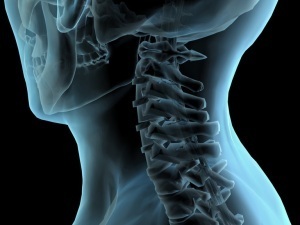Signs of cervical osteochondrosis in strong manifestations usually surprise the patient, although prerequisites for the disease are observed long before the onset of major symptoms and are the result of degenerative changes in the structure of the vertebrae. Often, nerve roots of levels C5, C6, C7 (cervical spine) are affected.
Clinical manifestations
Symptoms of cervical osteochondrosis are divided into radicular and reflex.
Reflex Syndrome

Lumbago is a characteristic of reflex symptoms. Their main feature is the appearance of awkward movements, jerks, or long heads in one position. Lumbago of the cervical spine literally knocks a person out of routine, movement becomes limited, the patient takes a forced position due to severe pain.
Frequent patient complaints:
- headaches radiating to the temples or eyeballs;
- decreased visual acuity, in front of the eyes as if "everything is floating";
- possible increase in pressure.
Vertebral artery syndrome occurs when the nerve plexus is irritated, which is often misdiagnosed as a cerebrovascular accident. Manifestations of cervical osteochondrosis with a similar syndrome are frequent dizziness with sharp head rotation, almost always accompanied by unpleasant nausea and vomiting.
It is important to exclude cerebrovascular accidents when making a diagnosis, because the treatment of osteochondrosis is fundamentally different from the treatment of diseases of the vascular system.
With cardialgic symptoms in the reflex syndrome clinic in cervical osteochondrosis, patients are characterized by a sensation reminiscent of angina pectoris attacks, but difficulty in accurately diagnosing the disease is usually not observed, as cardialgic symptoms are accompanied by a number of characteristic symptoms of spinal osteochondrosis.
Radicular Syndrome
Signs of cervical osteochondrosis in radicular syndrome appear in direct proportion to the "number" of compression nerves.
Symptoms, senses and motor changes depend on which nerve root is affected:
- C1- there is a violation of sensitivity in the occipital area;
- C2- patients feel pain in the parietal and occipital areas;
- C3- pain appears in the middle of the neck where the violation occurred. Symptoms: decreased sensitivity, work disorders and tongue contact, speech disorders;
- C4- there is pain in the shoulder-scapular area, impaired sensitivity, it can be painful in the heart and liver;
- C5- the patient does not feel the shoulder on its outer surface, worried about pain in this area;
- C6- pain in osteochondrosis at the level of the 6th vertebra extends to the forearm, scapula, radial surface and "descends" to the thumb;
- C7- pain "spreads" from the neck to the scapula, passing over the back of the shoulders and forearms, reaching 2-4 fingers, sensitivity in this area worsens;
- C8- pain is localized from the neck to the shoulders and then to the little finger.
Inseparable pathological connections

VSD and cervical osteochondrosis are closely related, and vegetative-vascular dystonia can manifest itself as a result of damage to the cartilage of the cervical joint, which loosens the human nervous system. Dystonia and osteochondrosis, which are detected at the same time, can be a common disease or VSD occurs for a common cause.
Osteochondrosis is one of the factors that provokes VSD, but it is not necessary that the latter occur from the first.
Vegeto-vascular dystonia often appears in various types of osteochondrosis, especially in cervical spine disorders. But it can also manifest itself as a result of injury, nerve compression in the cervical spine occurs, blood flow worsens and pressure in the skull increases.Diagnostic Error
VSD, osteochondrosis and thoracic pain are treated radically in different ways. Expensive (and often unnecessary) tests do not show problems other than problems in the cervical area, and disorders in the work of blood vessels. In this case, the treatment remains the same - heart complex, vitamins, antidepressants. Chiropractors relieve pain, arrange patients in an optimistic setting, but panic attacks, stress and fatigue go nowhere.
More and more people are falling victim to improper therapy, panic attacks (or VSD attacks) are common to them, but many patients still choose self-treatment or visit "doctors" whose activities are not aimed at getting rid of the disease, but to enrich themselvesalone.
Feature manifest group
The main clinical signs of cervical osteochondrosis can be divided into several groups:

- first.Neurological symptoms arise as a result of complications in cervical osteochondrosis and with direct pressure on the nerve root, nerve plexus;
- sec.Symptoms appear when directly affecting the spinal cord;
- third.Symptoms occur in the brain, affecting the ducts, structures, membranes and stems.
Each group listed has its own clinical signs and patterns of manifestation, but there are similarities in symptoms, which makes it possible to make a correct diagnosis.
Symptoms of osteochondrosis of the cervical vertebrae often appear as neurological complications, the hallmark of which is pain in the shoulder joint. This pathology is called "periarthritis of the shoulder scapula".
A characteristic feature of spinal cord compression in the cervical region is volumetric lesions in tissues and a strong decrease in vital function. Skin and muscle sensitivity is impaired, paresis develops, and in cases of complex pathology, paralysis.
That is why, even at the first suspicion of cervical osteochondrosis, it is important to visit a specialist, carry out the necessary diagnostic measures and undergo treatment. Remember that pathologies detected in a timely manner are eliminated quickly and without consequence.



































